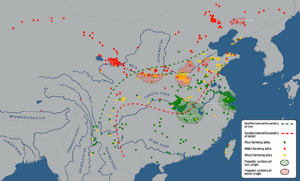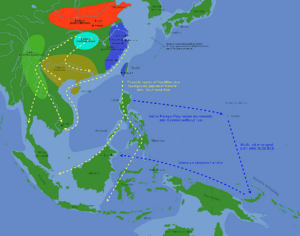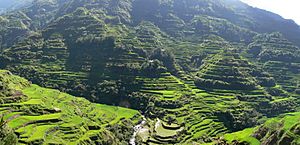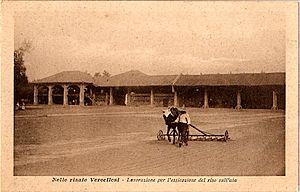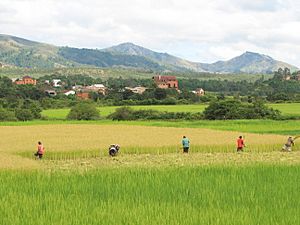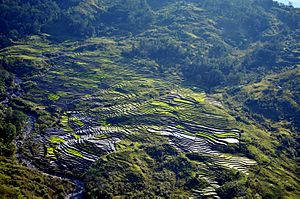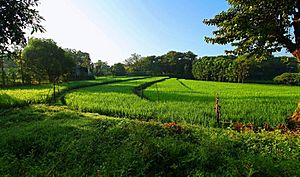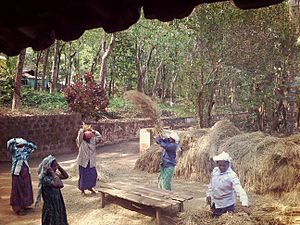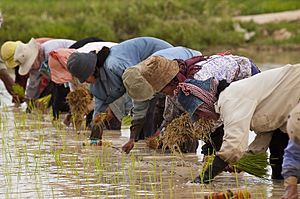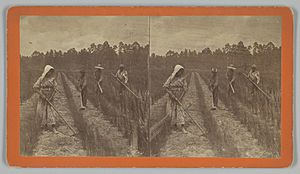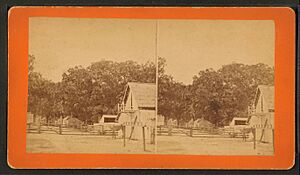History of rice cultivation facts for kids
The history of rice cultivation explores how humans first started growing rice, how it spread across the world, and how farming methods changed over time. Scientists believe that Oryza sativa rice, the most common type, was first grown in the Yangtze River area of China between 13,500 and 8,200 years ago. From there, people moving and trading helped rice spread across Asia and eventually to the Americas. Another type, Oryza glaberrima, was first grown in Africa about 3,000 to 3,500 years ago.
Rice is now a very important food for people worldwide. There are over 40,000 different kinds of Oryza sativa rice! New farming methods and special breeding have helped grow even more rice in recent years. Some new types, like golden rice, are even engineered to have extra nutrients.
Contents
How Rice Farming Began
Origins in China
Most scientists agree that rice farming began in the Yangtze River basin in China. Genetic studies show that all Asian rice types, both indica and japonica, came from a single wild rice plant called Oryza rufipogon. This happened between 13,500 and 8,200 years ago.
There were two main areas in China where rice farming and wetland agriculture (growing rice in flooded fields) likely started. One was in the lower Yangtze River region. People here built houses on stilts and were skilled in jade carving and boat building. They also ate acorns, water chestnuts, and raised pigs.
The second area was in the middle Yangtze River. People from both regions traded with each other. This helped rice farming spread throughout southern China.
Over time, rice was also introduced to northern China, where people mainly grew millet. Rice didn't replace millet there because of different environmental conditions. However, it became a secondary crop grown alongside millet in some areas.
By the late Neolithic period (3500 to 2500 BC), the number of people in rice-growing areas grew quickly. There was also clear evidence of intense rice farming in paddy fields. People in these areas developed complex societies.
Around 2500 to 2000 BC, these rice-growing cultures declined. This might have been due to conflicts and the movement of other groups from the north. This period also saw rice farming cultures move south into new regions. A global cooling event around 4,200 years ago also pushed tropical japonica rice south. It also led to the development of japonica rice that could grow in cooler, northern areas.
Southeast Asia
The cultivation of japonica rice spread to Southeast Asia with the Austronesian people. They moved from China to Taiwan between 3500 and 2000 BC. In Taiwan, there's evidence of intensive wetland rice farming from around 2800 BC.
From Taiwan, Austronesian people started moving south around 2000 to 1500 BC. They settled in the Philippines, bringing rice farming with them. From the Philippines, they quickly spread across Island Southeast Asia, reaching places like Borneo, Sumatra, Sulawesi, and Java. By 500 BC, advanced wetland rice farming was common in Java and Bali.
Rice, along with other plants, was also brought to Madagascar and East Africa by Austronesian settlers around 1000 AD. Much later, rice was brought to Guam between 900 and 1700 AD. Guam is the only island in Oceania where rice was grown before Europeans arrived.
In Mainland Southeast Asia, rice spread through trade along rivers. The earliest signs of rice farming in this region are from around 3000 BC. This includes sites in northern Thailand (around 2000 to 1500 BC) and southern Vietnam (around 2000 to 1200 BC).
Korean Peninsula and Japan

Dry-land rice was introduced to Korea and Japan between 3500 and 1200 BC. At first, rice was grown on a small scale. Farmers sometimes planted wild and domesticated grains together.
Intensive wet-paddy rice farming came to Korea around 850–550 BC. It reached Japan around 300 BC. A genetic study shows that the temperate japonica rice, common in Korea and Japan, developed after a global cooling event 4,200 years ago.
Indian Subcontinent
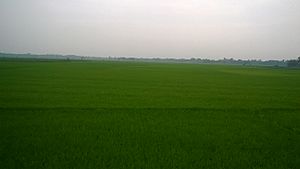
Evidence suggests rice was eaten in India as early as 6000 BC. Rice was definitely grown in the Indian subcontinent from 5,000 BC. Wild rice grew in the Vindhyan Hills, and farming there might have started around 7,000 years ago. Rice appeared in the Ganges valley in northern India between 4530 BC and 5440 BC.
Early rice farming in ancient India focused on the wild species Oryza nivara. This led to local methods of growing both 'wetland' and 'dryland' Oryza sativa var. indica rice. The true 'wetland' rice, Oryza sativa var. japonica, arrived around 2000 BC.
Rice was also grown in the Indus Valley civilization (around 3rd millennium BC). By the second millennium BC, rice was cultivated in the Kashmir and Harrappan regions.
Africa
While Oryza sativa rice came from Asia, another type, Oryza glaberrima, was first grown in Africa. This happened independently about 3,000 to 3,500 years ago. It spread from the Niger River delta to Senegal between 1500 and 800 BC. However, it didn't spread much further and its cultivation declined. The Asian rice species, introduced to East Africa early in history, became more popular.
Europe
Ancient Greeks knew about rice, getting it from Egypt and West Asia. Soldiers returning from Alexander the Great's travels to Asia brought it to Greece. Large amounts of rice from the first century AD have been found in Roman camps in Germany.
The Moors brought Asian rice to the Iberian Peninsula (Spain and Portugal) in the 10th century. Records show it was grown in Valencia and Majorca. The Moors might have also brought rice to Sicily in the 9th century. It was an important crop there long before it was noted in Italy's Po valley in the 1400s.
After the 15th century, rice spread throughout Italy and then France. Later, it spread to other continents during the age of European exploration. In Russia, a short-grain rice similar to Italian types is grown in the Krasnodar Krai. It's known as "Kuban Rice."
Rice Around the World
Asia
Today, most of the world's rice comes from countries like China, India, Indonesia, Bangladesh, Vietnam, Thailand, and Japan. Farmers in Asia still produce 87% of all rice. In Bangladesh, rice is the main food.
Indonesia
Rice is a main food for everyone in Indonesia. It's very important in Indonesian culture and Indonesian cuisine. Rice shapes the landscape, is sold in markets, and is part of most meals. It provides more than half the calories in the average diet. About 20 million families earn their living from rice. The importance of rice is shown by how people respect Dewi Sri, the rice goddess of ancient Java and Bali.
Signs of wild rice on the island of Sulawesi date back to 3000 BC. The earliest written records of rice farming come from stone carvings in central Java from the 8th century. These show kings collecting taxes in rice. Images of rice farming, rice barns, and mice in rice fields can be seen in the old carvings of Borobudur. Carvings on the 9th-century Prambanan temples in Central Java show how work was divided: a water buffalo pulling a plow, women planting seedlings, and men carrying rice. In the 16th century, Europeans saw rice as a special food served to important people during celebrations.
Nepal
Rice is the main food for all groups in Nepal. In the Terai region, most rice is grown during the rainy season (June to July). This is when there's enough water for some fields. A second season, from April to September, usually has enough water for all rice fields. Farmers use irrigation channels to water their crops.
Philippines
The Banaue Rice Terraces are 2,000-year-old terraces carved into the mountains of Ifugao in the Philippines. The ancestors of the Igorot people built them. These terraces are often called the "Eighth Wonder of the World". It's believed they were built mostly by hand with simple tools. The terraces are about 1,500 meters (5,000 feet) above sea level. An old irrigation system from the rainforests above feeds them with water. If the steps were laid end to end, they would go halfway around the world!
The Ifugao people are the caretakers of these terraces. Their culture is deeply connected to rice. They have many celebrations linked to rice farming, from planting to eating. The harvest season usually involves thanksgiving feasts. The final harvest rites, called tango or tungul, are a day of rest where no farm work is allowed. Drinking bayah (rice beer) and eating rice cakes are important parts of these celebrations.
The Ifugao people use traditional farming methods. They spend most of their time working on their terraces and in forest lands. They also grow root crops, edible shells, fruit trees, and other vegetables. The terraces are built with stone and earth walls designed to bring water from a main irrigation canal. The Ifugao people have amazing knowledge of water irrigation, stonework, and terrace care. The rice terraces have supported and shaped their community for generations.
Sri Lanka
Rice is the main food for all groups in Sri Lanka. Agriculture in Sri Lanka relies heavily on rice farming. Rice production depends a lot on rainfall. The government helps by supplying water through irrigation channels. The main growing season, "Maha," is from October to March, with enough water for all fields. The second season, "Yala," is from April to September, but only has enough water for half the land. Traditional rice types are becoming popular again as people become interested in natural foods.
Thailand
Rice is Thailand's main export, especially white jasmine rice 105. Thailand has many different rice types, about 3,500 kinds, and five types of wild rice. Each region of the country has different rice seeds. Their use depends on the weather, atmosphere, and land features.
The northern region has both low and high lands. Farmers usually grow non-glutinous rice like Niew Sun Pah Tong. This rice is naturally protected from leaf disease. The northeastern region is a large area where farmers grow a lot of rice. Even though it's mostly dry plains, white jasmine rice 105, Thailand's most famous rice, grows well there. This rice is soft, white, and fragrant. It can also handle drought, acidic soil, and alkaline soil.
The central region is mostly flat plains. Most farmers grow Jao rice, like Pathum Thani 1. This rice is similar to white jasmine 105 and is also fragrant when cooked.
In the southern region, farmers plant rice in flood plains or between mountains. Farming here is slower because the rainy season starts later. Popular rice types include Leb Nok Pattani seeds, a type of Jao rice. This rice can be used to make noodles.
Companion Plant
One of the oldest examples of companion planting is growing rice with Azolla, a small fern. Azolla covers the water in a rice paddy, blocking out other plants that might compete with the rice. It also helps add nitrogen from the air to the soil, which the rice uses. Farmers plant the rice when it's tall enough to grow above the azolla. This method has been used for at least a thousand years.
Middle East
Rice was grown in parts of Mesopotamia (southern Iraq). With the rise of Islam, it spread north to the southern shores of the Caspian Sea in Iran. It then moved beyond the Muslim world into the Volga River valley. In Egypt, rice is mainly grown in the Nile Delta. In Palestine, rice was grown in the Jordan Valley. Rice is also grown in Saudi Arabia and Yemen.
Caribbean and Latin America
Most of the rice eaten in the Americas today is not native. It was brought to Latin America and the Caribbean by European explorers long ago. However, there are at least two native types of rice in the Amazon region of South America. Indigenous people there used these to create domesticated forms about 4000 years ago.
Spanish explorers brought Asian rice to Mexico in the 1520s. The Portuguese and enslaved Africans brought it to colonial Brazil around the same time. Many historians believe that enslaved Africans played a key role in establishing rice in the Americas. They brought their knowledge of rice farming with them. Dishes made with rice and beans, which were common in West Africa, remained a main food for their descendants in the Americas.
North America
Rice arrived in South Carolina in 1694, likely from Madagascar. A story says that a pirate named John Thurber gave a bag of rice seeds to Dr. Henry Woodward. Woodward planted the rice and found it grew very well in the wet Carolina soil.
Growing rice was a challenge for European settlers who didn't know the crop. Native Americans, who mostly gathered wild rice, also didn't have experience with rice farming. However, within 50 years, rice became the most important crop in South Carolina.
In the United States, colonial South Carolina and Georgia became very wealthy from rice. Enslaved people from the Senegambia area of West Africa and Sierra Leone were brought to these regions. They were highly valued because they already knew how to grow rice. This knowledge was used on the many rice plantations around Georgetown, Charleston, and Savannah.
Enslaved Africans taught plantation owners how to build dikes in the marshes and flood the fields. At first, rice was processed by hand using large wooden tools. Then it was cleaned in sweetgrass baskets, a skill also brought from Africa. The invention of the rice mill made growing rice more profitable. Adding water power to the mills in 1787 was another big step forward.
Rice farming in the southeastern U.S. became less profitable after the American Civil War when slavery ended. It eventually stopped completely in the early 1900s. Today, you can visit the historic Mansfield Plantation in Georgetown, South Carolina. It's the only remaining rice plantation in South Carolina with its original cleaning barn and rice mill from the mid-1800s. The main type of rice grown in the Carolinas was from Africa and was called 'Carolina Gold'. This type has been saved, and there are efforts to grow it commercially again.
In the southern United States, rice has been grown in southern Arkansas, Louisiana, and east Texas since the mid-1800s. Many Cajun farmers grew rice in wet marshes and low-lying prairies. They could also farm crayfish when the fields were flooded. In recent years, rice production has increased in North America, especially in Arkansas and Mississippi.
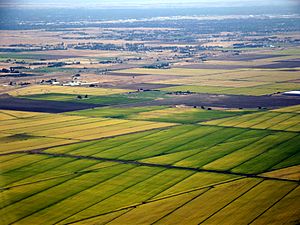
Rice farming began in California during the California Gold Rush. About 40,000 Chinese workers came to the state and grew small amounts of rice for themselves. However, commercial production started in 1912 in Richvale. By 2006, California produced the second-largest rice crop in the U.S., after Arkansas. Production is mainly in six counties north of Sacramento. California mostly grows short- and medium-grain japonica varieties, like Calrose, which makes up 85% of the state's crop.
More than 100 types of rice are grown for sale in six U.S. states: Arkansas, Texas, Louisiana, Mississippi, Missouri, and California. In 2006, U.S. rice production was worth about $1.88 billion, with about half of it being exported. The U.S. provides about 12% of the world's rice trade. Most U.S. rice is used directly as food (58%). Some is used in processed foods and beer (16% each), and 10% goes into pet food.
Oceania
Rice was one of the first crops planted in Australia by British settlers. They had experience with rice farms in the Americas and India.
Attempts to grow rice in northern Australia failed for many years. This was due to problems with iron and manganese in the soil and damage from pests.
In the 1920s, rice was seen as a possible irrigation crop in the Murray–Darling basin. The soils there were too heavy for fruit and not fertile enough for wheat.
Because irrigation water was very cheap, growing rice became popular over the next decades. Californian types of rice worked well in the Riverina climate. The first rice mill opened in Leeton in 1951.
Even before this, Australia produced much more rice than it needed. Rice exports to Japan became a major source of money. High rainfall from the 1950s to the mid-1990s helped the Riverina rice industry grow. However, its huge water use in a dry region started to concern environmental scientists. They worried about declining water flow in the Snowy River and the lower Murray River.
Growing rice in Australia is very profitable because land is cheap. But several recent severe droughts have led many to call for less rice farming. This is because of its effects on very delicate water ecosystems. The Australian rice industry changes its planting area each season depending on how much water is available from the Murray River and Murrumbidgee River irrigation regions.
Australian Aboriginal people have harvested native rice types for thousands of years. There are ongoing efforts to grow these native species for commercial use.


